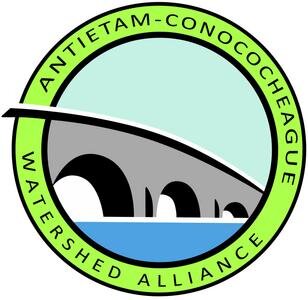Safe Swimming & Creek Bacteria
Example of Bacteria Results published on Swim Guide in 2022
Volunteer sampling event along the Antietam Creek in June 2022
Our creeks are wonderful locations for outdoor recreation such as boating, swimming, tubing, or fishing, but it is important to know harmful bacteria could potentially be present in the water. You cannot see bacteria but you can be aware of conditions when their levels could be dangerous. Learn the steps to protect yourself from illness or infection.
Bacteria is present naturally in our streams and creeks, however excessive bacteria from fecal sources (such as manure and sewage) is unsafe for humans and animals. Bacteria levels can rise when water flows slowly, temperatures warm, rain washes bacteria into the creeks, or if there is a direct source like livestock in the waters or illegal sewage discharges into the waters. The Antietam and Cononocheague Creeks have all experienced high bacteria levels that could be cause for concern for those in recreating in the waters.
This summer (2022), you can check for bacteria level advisories at select spots on the Antietam Creek and Potomac River from samples collected by the Potomac RiverKeeper Network (PRKN). The samples are test for e. coli, which is present in the gut of warm-blooded animals (including humans), and is used an indicator of fecal bacteria. The advisories are posted each week for PRKN sites on the Swim Guide website and the companion downloadable app. ACWA’s monthly samples are posted on our data webpage.
Be aware of water conditions that could indicate high levels of bacteria such as sewage smells, stagnate water, and muddy colored waters. Remember wash your hands before eating or drinking. Avoid contact with contaminated water including: water in the eyes, ears, mouth, and also entering open cuts or sores on the skin. Consult medical help if you feel ill after being in the water, or if you injure yourself while in the creek, including fish hook punctures and cuts on the rocks.
The Center for Disease Control (CDC) lists steps on their website to keep you and your family safe when recreating in natural waters such as the ocean or streams. Additionally, the Maryland Department of the Environment “Healthy Beaches Report” for 2022 recommends “to avoid swimming within 48 hours of a heavy rain event” and other safe swimming practices.
The best protection against bacteria exposure is knowing when to avoid going in the waters. Learn more about Potomac Riverkeeper Network’s bacteria monitoring program or ACWA’s Citizen Science Program on their websites.
edited 6/22/22 to include reference to MDE’s 2022 Healthy Beaches Report and 7/1/22 to include link to ACWA Citizen Science Data website.



